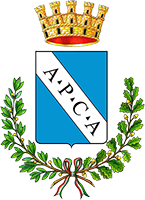
PORTA ROMANA
Porta Romana is the most central and most majestic of the four gates that allow access to the historical center of the city. The others are Porta Leone IV, Porta Posterola and Porta della Valle, which is also the most modern of the four.
The current appearance dates to the sixteenth century, when it was modified and rebuilt in travertine. In medieval times, the Gate was called “Busolina”, name of unknown origin. In 1703, Amelia’s inhabitants, survived from a major earthquake, dedicated the city to the Virgin Mary, placing a plaque on the door’s pediment with the inscription CIVITAS MARIÆ VIRGINIS IN NOMINE IESV A TERRÆMOTV LIBERATA A.D. MDCCIII and a brick image of Our Lady of the Assumption was embedded below it. The image currently visible on Porta Romana, is a perfect metal copy of the original wooden board, which was created in the nineteenth century to replace an older representation, which is now preserved, after careful restoration, in a room of the Museum. The access gap consists of a round arch, four meters wide and six meters high; the maximum height of the Gate is 16 meters while the maximum width is approximately 10.90 meters.
The Gate, fully restored in the end of 2013, is surmounted by embrasures in Renaissance brick and it still preserves the two doors made of cedar wood. In the barrel shaped vault, a fresco representing the city’s crest appears. Here, in a white silver band on a blue background, we find the acronym A.P.C.A., which stands for Antiani Populi Civitatis Ameriae (“THE ELDERS OF THE CITY OF AMELIA”), that is the most important elective organ of the city from the XIV century’s statutes. During the historical reenactment that takes place every year in August, following the ancient statutes of 1346, the Gate, with an impressive ceremony, is closed and then reopened to accommodate the Podestà (chief magistrate of a city state) from Rome.
PORTA LEONE
In the middle of the ninth century, Pope Leo IV (ruling from the year 847 until his death in 855) reinforced the western stretch of the city walls, probably to improve the defense of the city against Saracen raids. Another pontiff with the same name, Pope Leo X (born Giovanni de’ Medici, Florence 1475 – Rome 1521) ordered a new work of fortification be carried out on the city walls a few centuries later. The project is described in some surviving sketches (dated 1517-18) by Antonio da Sangallo il Giovane (Florence 1484 – Terni 1546), which are nowadays preserved in the Uffizi Gallery in Florence (Department of Prints and Drawings). However, the Gate we admire today takes its name from the previous Pope, as it belongs to the walls’ section restored in the ninth century under the will of Leo IV.
For this reason, the gate dates to the Medieval Age, although traces of the Roman gateway still survive at the base of the current structure. At the top, we see a prominent bartizan, that is a rectangular turret, equipped with loopholes which allowed the guards to defend the gate located below without being exposed. The gate gives access to the neighborhood bearing the same name, where, since ancient times, most of the artisans and craftsmen used to live and work. Blacksmiths, carpenters, coalmen, farriers, bakers and innkeepers had their workshops in this area, which is still today one of the most picturesque of the town. The stretch of walls rebuilt under the will of Pope Leo IV, also included Porta del Sole. This gate was discovered after the bombardment of the Second World War, which occurred on January 25th, 1944. The remains of the road that led to the city have been brought to light, in the gardens just inside the walls. The Gate is somewhat higher than the street level: This suggests the almost certain presence of a drawbridge.
All the walls around Pope Leo’s Gate suffered damage in the Second World War and some rebuilding was carried out in the 1950s. In 1998-2000, repairs and excavations held both unearthed ceramics from the third century BC and an inscription on the base of a statue, which records that the Decurions (representatives of the municipal government) had dedicated the statue to Cornelius Saloninus, emperor Galienus’son (about 218 – 268 AD). The inscription probably dates to the period between 258 AD, when Saloninus became Caesar, and 260 AD, the year of his death.
A 30-meters section of the walls, about 200 meters from Pope Leo’s Gate along Via Nocicchia, collapsed in 2006 and is still in refurbishment. The final project aims to give life to an archaeological park to preserve the Medieval walkway guard that runs above the walls, recognizable by a low wall that served as a parapet. For this reason, a cylindrical watchtower (which nowadays houses a public elevator), that probably provided accommodation to the guard, stands close to this section.
PORTA POSTEROLA
Posterola Gate dates from the 13th century and it is an interesting construction composed of two doorways placed perpendicularly to one another. Between them, there is a small courtyard, once used by the guardsmen, who lived in the watchtower, to check the cart shipments and the people’s passage, demanding the possible duties. Various interventions are documented in 1340, in 1402-1405 when the tower was repaired and at the beginning of the 17th century, when the drawbridge was strengthened. The gate takes its name from a linguistic corruption of the late Latin word posterula (= rear), used here in the sense of secondary entrance, placed in a less flashy location than Porta Romana, the main gate of the city. Generally, a posterola allowed the passage of one person at a time, in order to to better control the access.
PORTA LA VALLE
The Gate of the Valley is situated at a remarkable height in respect to the route underneath. It represents the only entrance gate in the north-west section of the Medieval walls, and it is reachable by foot from the external part of the walls just through a path that starts from the so-called “Winter Gardens”. It is a panoramic point of observation, and, during the past, it was a decisive military place on the Amerina Valley, that offers an incredible view of the hills that softly downgrade towards the Teverina of the Umbria and Lazio side. The current Gate dates from the 13th century and a circle-map tower with a remarkable diameter rises near it. It is itself too the witness of the reinforcement of the walls, which occurred in that period, interesting the entire perimeter. New city entries fortified with adjacent guard towers were purpose-built to defend the city, such as Posterola Gate. Gate of the Valley gave the name to the Valley district, once known as “Vallis”: the life of its inhabitants was closely linked to the functions of access and defense of the gate. The Council of Elders decided that the city gates couldn’t be opened after the evening closing, and that in the case of noise, 25 guardsmen were placed at its watch. The garrison stationed here was used to control the movements of enemy troops which might be spotted by the castle of Porchiano or from the towers along the route of the Via Amerina. Inside the district, the high walls protected the gardens and the lower houses which, in case of danger, had to be patrolled and have the windows blocked at the expense of the owners. Even today, walking in Via Piacenti, you can admire the lush gardens and terraced vegetable gardens of private property.


